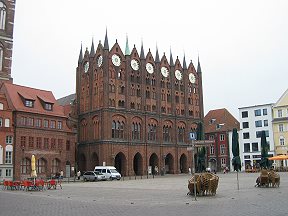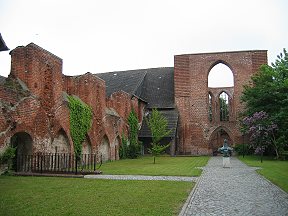Worth seeing - form Stralsunds history
Stralsund received in 1234 Lübisch municipal law. The geographical situation presented the best condition for founding the city and its development. Old inland trade routes, from the direction of Damgarten, Tribsees and Demmin led to the island Rügen. The surrounding ponds offered cover from the attacks which were coming from the mainland.
In the middle ages, the economical basis was the sea trade. With the cities growing economy, a greater independence was emerging. The cities joined together into the Hanse, to protect their interests. In 1293 Lübeck, Wismar, Rostock, Greifswald and Stralsund joined the Hanse.

The development of the city was interrupted by wars.
Grand buildings, like the brick-gothic town-hall, the parish churches, convent grounds, bulwarks and several gable houses are still reminding us today of the cities affluence in the past .

Through the cities history, the fight of the inhabitants against the few families of the upper class draws like a red thread. The striving towards a democratic Constitution failed.
Stralsund lost its distinguished importance with the decline and collapse of the Hanse.
The Swedish time was instituted in 1628 through commencement of the council with the North-European great power under King Gustav ll. against Wallenstein. Stralsund with Vorpommern belonged from 1648 to 1815 to Sweden. This affiliation was by no means good. Again and again they were involved in wars of the Swedish kings.
In 1815 the city became part of Preußen. Nearly all vehicles for the marine were build at the Stralsund dockyard.
After the sale of the island Dähnholm to the armed forces in 1849 arose here the marine depot, 'The cradle of the Prussian marine'.

